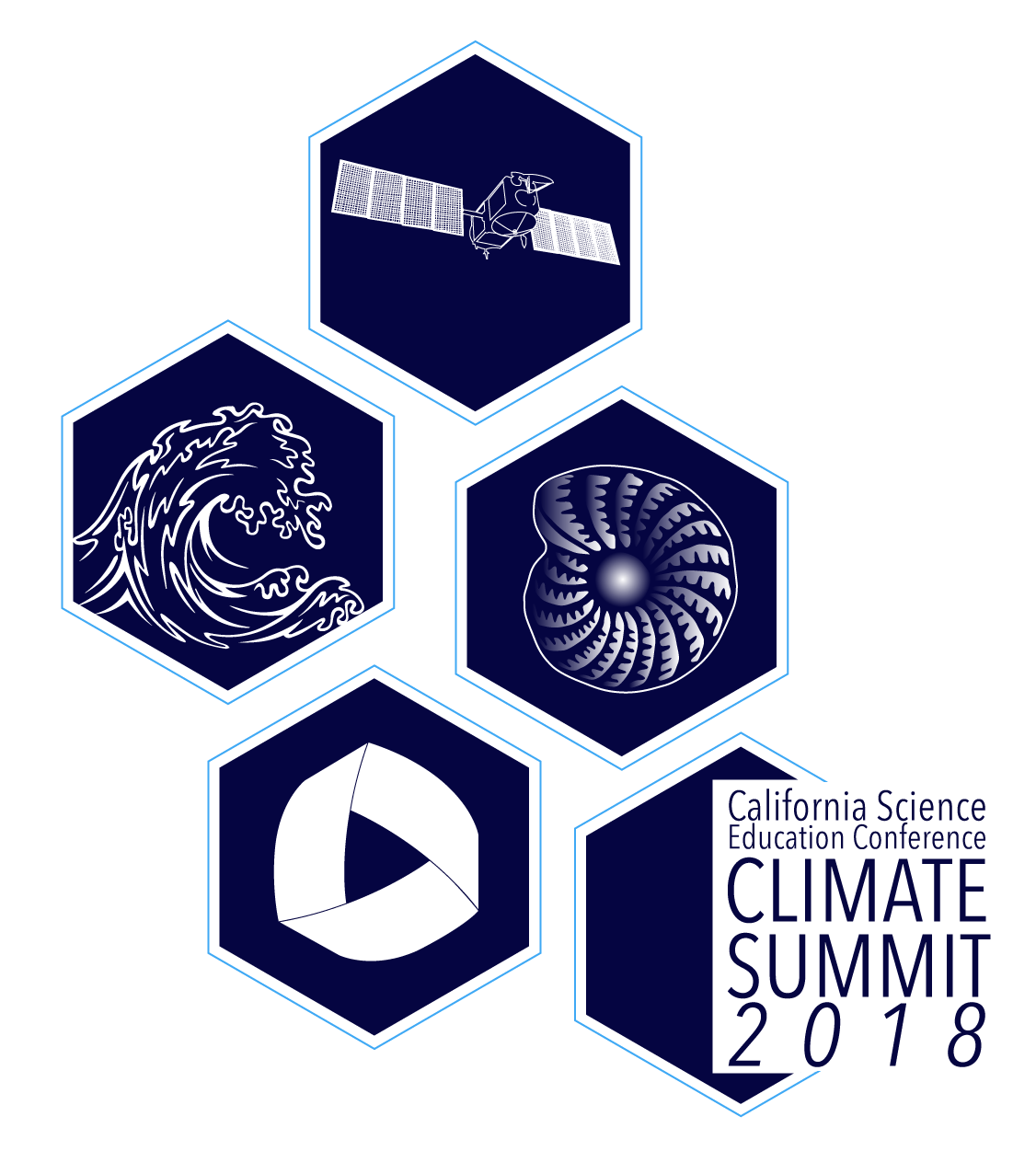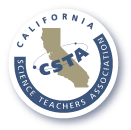
Climate Summit - Conference Events

California Science Education Conference Event Navigation Menu
REGISTRATION IS NOW OPEN

Add Short Course, Field Tour and Sound of Music to your Conference Experience.
Climate Summit Events @ the 2018 California Science Education Conference
The following events are a part of the Climate Summit and are embedded within the California Science Education Conference. Registration for the Climate Summit Pre-Conference Day does not include the California Science Education Conference. Registration to the 2018 California Science Education Conference is required for participation in any of the events listed below.
Friday, November 30, 2018 |
|
| 8:00 am - 9:30am | Focus Speaker: Turning Misconceptions/Misinformation Into Educational Opportunities Learn about a new unit of climate change lessons developed using a misconception-based approach and evidence-based pedagogy. The lessons were created at a workshop with classroom teachers called Turning Misinformation into Educational Opportunities. Workshop facilitators included John Cook, a research assistant professor at the Center for Climate Change Communication at George Mason University who developed the misconception-based approach, Frank Niepold, Senior Climate Education Program Manager for NOAA, and Brad Hoge, Director of Teacher Support at the National Center for Science Education (NCSE). The five lesson unit is built around misconceptions specifically identified in the Heartland Institute's mailing utilizing a unique inquiry strategy to inoculate students to misconceptions.
|
| 10:10 am - 11:10 am | Keynote Presentation - Why Should We Trust Science?
|
| 2:30 pm - 5:30 pm | SC06: Ice, Ice Baby This short course is being presented as part of the Climate Summit. Participants experience a 6th grade learning sequence focusing on Earth’s heat balance and the melting of ice. Receive a full unit conceptual flow and targeted learning sequence plans aligned to the NGSS and incorporating California's Environmental Principles and Concepts.
This short course is being presented as part of the Climate Summit. Participants experience a high school Chemistry and Earth and Space Science learning sequence focusing on ocean acidification and chemical equilibria through the lens of the plight of west coast oysters. Receive a full unit conceptual flow and targeted learning sequence plans aligned to the NGSS and incorporating California's Environmental Principles and Concepts.
This short course is being presented as part of the Climate Summit. It is designed to highlight effective practices by informal centers in partnership with classroom teachers that address climate change issues facing communities.
|
| 4:20 pm - 5:50 pm | Focus Speaker: Data From the Skies Warn of Disasters on the Ground Hazards, such sea level rise and coastal erosion, as well as natural and anthropogenic hazards and disasters such as tsunamis and earthquakes, tropical cyclones, oil spills, etc. are a regular consequence of life on Earth. But space borne and airborne Earth observations are now able to provide a synoptic and time-critical situational awareness to responders and decision makers during a disaster, and long-term assessment and evaluation of changes and impacts resulting from disasters. Geophysicist Maggi Glasscoe of the Jet Propulsion Laboratory will discuss how Earth observations from satellites and aircraft can be used to monitor natural hazards and disasters through airborne projects like Uninhabited Aerial Vehicle Synthetic Aperture Radar (UAVSAR) and data synthesis programs like the Advanced Rapid Imaging and Analysis (ARIA) Project for Natural Hazards project.
|
Saturday, December 1, 2018 |
|
| 8:30 am - 11:30 am | SC14: Don't Dry For Me California This short course is being presented as part of the Climate Summit. Participants build understanding of how the availability of water impacts living and nonliving things in our environment across K-2 and experience sample NGSS-aligned lessons at each grade. Receive a full unit conceptual flow and targeted learning sequence plans aligned to the NGSS and incorporating California's Environmental Principles and Concepts.
This short course is being presented as part of the Climate Summit. Participants experience a 7th grade learning sequence about oxygen minimum zones in the ocean and their effect on marine ecosystems and artisanal fisheries. Receive a full unit conceptual flow and targeted learning sequence plans aligned to the NGSS and incorporating California's Environmental Principles and Concepts.
This short course is being presented as part of the Climate Summit. Participants experience a High School Life and Earth and Space Science learning sequence about the effects of temperature, carbon dioxide, and sea level rise on coastal marine ecosystems and coral reefs. Receive a full unit conceptual flow and targeted learning sequence plans aligned to the NGSS and incorporating California's Environmental Principles and Concepts.
|
| 10:00 am - 11:30 am | Focus Speaker: Rivers in the Sky California has no mighty rivers like the Mississippi, but rivers of a different kind can flood the state. In winter 2017, more than a meter of precipitation fell in some places, unleashing floods, triggering landslides, and causing evacuation of 200,000 people. It’s all because of atmospheric rivers: long, narrow ribbons of water vapor rushing across the sky. Just a few hundred kilometers wide, atmospheric rivers stretch thousands of kilometers from the tropical oceans toward the poles, carrying on average 25 times as much water as the Mississippi River, but as vapor rather than liquid. When atmospheric rivers make landfall, and the vapor condenses, they can release a staggering amount of rain and snow. Join Scripps Institution of Oceanography meteorologist Marty Ralph, Director of the Center for Western Weather and Water Extremes as he describes the phenomena of atmospheric rivers, their impact on our weather, and the essential role modeling and prediction play in managing California’s precious water resources.
|
| 3:00 pm - 4:30 pm | Focus Speaker: The Reverse Keeling Curve: Earth’s Climate History Preserved in Ancient Ice Many are familiar with the Keeling Curve, the iconic record of increasing CO2 in earth’s atmosphere established by Scripps Oceanography scientist Charles David Keeling in 1958 – but how do we know about CO2 before then? Drilling down thousands of meters into the ancient ice preserved on Earth’s massive continental ice sheets, scientists can extract a wealth of information about our climate history – including periods both much colder and considerably warmer than today. Ice, dust and tiny gas bubbles in Greenland and Antarctic ice provide myriad clues into the complex workings of Earth’s climate system. Join Scripps Institution of Oceanography paleoclimatologist Dr. Jeff Severinghaus as he describes how he delves into Earth’s climate past to gain insight into our climate future.
|
| 3:00 pm - 6:00 pm | SC20: Dangerous Earth This short course is being presented as part of the Climate Summit. Participants build understanding of the effects of changes within Earth’s Systems across grades 3-5 and experience sample NGSS-aligned lessons at each grade. Receive a full unit conceptual flow and targeted learning sequence plans aligned to the NGSS and incorporating California's Environmental Principles and Concepts.
This short course is being presented as part of the Climate Summit. Participants experience a high school Physics and Earth and Space Science learning sequence focusing on 100% Renewable Energy by 2045, engineering a solution, and considering the pros and cons of possible solutions to meet Governor Brown’s Climate Initiative. Receive a full unit conceptual flow and targeted learning sequence plans aligned to the NGSS and incorporating California's Environmental Principles and Concepts.
This short course is being presented as part of the Climate Summit. Participants experience an 8th grade learning sequence focusing on the increase in CO2 on Earth, how it affects seals and sea ice, and what students can do about it. Receive a full unit conceptual flow and targeted learning sequence plans aligned to the NGSS and incorporating California's Environmental Principles and Concepts.
|
| 4:45 pm - 6:15 pm | Focus Speaker: Exploring Earth from Space and Being a Scientist in 2018 Every year, NASA and many international partners have added new satellites and instruments to an array of sensors already in space to study how and where the Earth is changing. These capabilities in orbit have required a new generation of scientists to make the discoveries, to exploit the exciting opportunity, and to advance our fundamental understanding of the planet we call home. Over the past thirty years, the skills we need for this research have changed. In this talk, I will look back at the evolution of the Earth science space program, the opportunities for young scientists, and what it might tell us about what they need to know.
|
Sunday, December 2, 2018 |
|
| 8:00 am - 9:30 am | Keynote Address - Climate Change: How Do We Bend the Curve?
|
Upcoming Conferences
- 2024 Conference
November 8-10
Sacramento, CA - 2025 Conference
October 17-19
Palm Springs, CA











